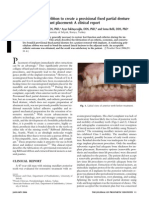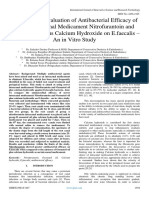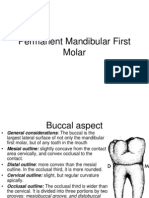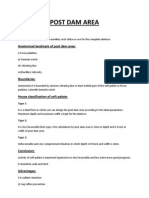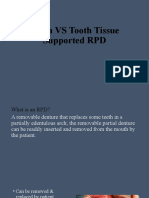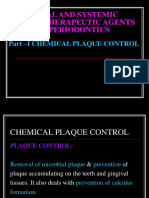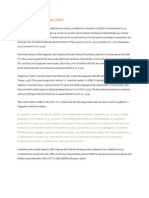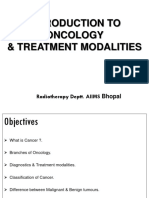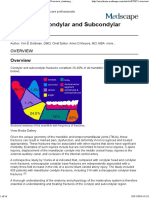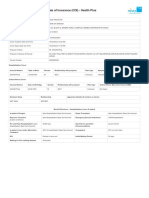0 ratings0% found this document useful (0 votes)
72 viewsVit K in Wound Healing
Vit K in Wound Healing
Uploaded by
Rishabh KapoorThe document discusses wound healing and vitamin K administration for newborns. It describes three types of wound healing: primary intention where edges are drawn together, secondary intention where a wound is left open to heal from the bottom up, and tertiary intention where a wound is kept open to allow infection or edema to resolve. It also provides guidelines for vitamin K administration, noting it is essential for preventing bleeding and can be given either orally in three doses or via injection for some babies.
Copyright:
© All Rights Reserved
Available Formats
Download as PPTX, PDF, TXT or read online from Scribd
Vit K in Wound Healing
Vit K in Wound Healing
Uploaded by
Rishabh Kapoor0 ratings0% found this document useful (0 votes)
72 views9 pagesThe document discusses wound healing and vitamin K administration for newborns. It describes three types of wound healing: primary intention where edges are drawn together, secondary intention where a wound is left open to heal from the bottom up, and tertiary intention where a wound is kept open to allow infection or edema to resolve. It also provides guidelines for vitamin K administration, noting it is essential for preventing bleeding and can be given either orally in three doses or via injection for some babies.
Original Description:
role of k
Original Title
vit k in wound Healing
Copyright
© © All Rights Reserved
Available Formats
PPTX, PDF, TXT or read online from Scribd
Share this document
Did you find this document useful?
Is this content inappropriate?
The document discusses wound healing and vitamin K administration for newborns. It describes three types of wound healing: primary intention where edges are drawn together, secondary intention where a wound is left open to heal from the bottom up, and tertiary intention where a wound is kept open to allow infection or edema to resolve. It also provides guidelines for vitamin K administration, noting it is essential for preventing bleeding and can be given either orally in three doses or via injection for some babies.
Copyright:
© All Rights Reserved
Available Formats
Download as PPTX, PDF, TXT or read online from Scribd
Download as pptx, pdf, or txt
0 ratings0% found this document useful (0 votes)
72 views9 pagesVit K in Wound Healing
Vit K in Wound Healing
Uploaded by
Rishabh KapoorThe document discusses wound healing and vitamin K administration for newborns. It describes three types of wound healing: primary intention where edges are drawn together, secondary intention where a wound is left open to heal from the bottom up, and tertiary intention where a wound is kept open to allow infection or edema to resolve. It also provides guidelines for vitamin K administration, noting it is essential for preventing bleeding and can be given either orally in three doses or via injection for some babies.
Copyright:
© All Rights Reserved
Available Formats
Download as PPTX, PDF, TXT or read online from Scribd
Download as pptx, pdf, or txt
You are on page 1of 9
QUERIES TO SEMINAR :
ORAL WOUND HEALING
A clinician may
intentionally allow
a wound to heal by
secondary
intention to
prevent infection
in wounds in
which there is
significant
bacterial
contamination,
foreign bodies, or
extensive tissue
trauma. By leaving
the wound open,
there is less chance
that bacterial
colonization will
occur (i.e., the risk
of wound infection
is reduced).
Tertiary Intention
When a wound is intentionally kept open
to allow edema or infection to resolve or to
permit removal of exudate, the wound
heals by tertiary intention, or delayed
primary intention. These wounds result in
more scarring than wounds that heal by
primary intention but less than wounds
that heal by secondary
intention. (Johnstone, Farley,& Hendry,
2005)
Vit k to new born
If you choose vitamin K by
mouth, your baby must
have three doses:
Dose 1 at birth
Dose 2 usually three to five
days later, and
Dose 3 in the fourth week, if the
baby is fully
breast fed. (Babies fed mainly by
formula do not need the third
dose)
If your baby vomits within one
hour of swallowing the
vitamin K, the baby will need to
have another dose.
Can all babies have vitamin K?
All babies need to have vitamin K. Very
small
or premature babies may need smaller
doses
your doctor can advise you about this.
Vitamin K by mouth is not suitable for
some babies:
Babies who are premature or sick should
be given the vitamin by injection. There are
two main reasons for this: the very small
dose
needed is difficult to measure by mouth,
and
these babies are also more likely to have
feeding difficulties.
If you choose vitamin K by mouth but
your
baby is unwell when a dose is due, the
baby
may need to have the injection instead.
If, while you were pregnant, you took
medication for epilepsy, blood clots
or tuberculosis, you should tell your doctor
or midwife. Your baby may not be able
to absorb vitamin K by mouth, and may
need the injection instead.
How is vitamin K given?
The easiest and most reliable way to give
babies
vitamin K is by injection. One injection just
after birth
will protect a baby for many months.
Vitamin K can also be given by mouth.
Several
oral doses are essential to give enough
protection,
because vitamin K is not absorbed as well
when
it is given by mouth and the effect does not
last
as long.
Vitamin K helps blood to clot. It is essential to
prevent serious bleeding.
Babies do not get enough vitamin K from their
mothers during pregnancy, or when they are breast
feeding. Without vitamin K, they are at risk of getting
a rare disorder called Vitamin K Deficiency Bleeding,
or VKDB. VKDB can cause bleeding into the brain,
and may result in brain damage or even death.
VKDB can be prevented by giving new babies
extra vitamin K. By the age of about six months,
they have built up their own supply.
You might also like
- Sample Research ProtocolDocument5 pagesSample Research Protocollpolvorido100% (1)
- Primary Health Care: Mr. John Michael M. Pitoy, B.S.N., R.NDocument44 pagesPrimary Health Care: Mr. John Michael M. Pitoy, B.S.N., R.NJohn Michael Manlupig Pitoy100% (9)
- Enamel Acid Etching - A ReviewDocument8 pagesEnamel Acid Etching - A ReviewAmee PatelNo ratings yet
- KOD Final Year (M.B.B.S) - Survival GuideDocument30 pagesKOD Final Year (M.B.B.S) - Survival GuideMubasharAbrarNo ratings yet
- Cognitive DisordersDocument9 pagesCognitive Disordersgeorgeloto12No ratings yet
- MDS Qpapers 2019Document4 pagesMDS Qpapers 2019Smila Mahajan NangiaNo ratings yet
- Eriatric Nutrition: A Prosthodontic Review: AsssaasasasssDocument5 pagesEriatric Nutrition: A Prosthodontic Review: AsssaasasasssMaqbul AlamNo ratings yet
- Developmental Anamolies of Soft Tissues of Oral CavityDocument73 pagesDevelopmental Anamolies of Soft Tissues of Oral Cavityvellingiriramesh53040% (1)
- Pre Prosthetic SurgeryDocument29 pagesPre Prosthetic SurgeryDentist HereNo ratings yet
- ORAL SURGERY FlashcardsDocument9 pagesORAL SURGERY FlashcardsMihika MahandwanNo ratings yet
- Immediate DentureDocument48 pagesImmediate DenturesunithabanavathNo ratings yet
- Matrix Band PlacementDocument8 pagesMatrix Band PlacementEllizabeth LilantiNo ratings yet
- L3. Apexogenesis - ApexificationDocument44 pagesL3. Apexogenesis - ApexificationAGENG RAHMA HIJAHANIS ILMASTITI 1100% (1)
- Complete Dentures: Establishing and Maintaining Mandibular Equilibration With Complete DenturesDocument6 pagesComplete Dentures: Establishing and Maintaining Mandibular Equilibration With Complete DenturesAmar Bhochhibhoya100% (1)
- Seminar15 Mid 180118092933Document89 pagesSeminar15 Mid 180118092933Aditee AgrawalNo ratings yet
- Teeth SelectionDocument77 pagesTeeth SelectionAnurag AgarwalNo ratings yet
- Rationale For Dental ImplantsDocument18 pagesRationale For Dental ImplantsSamir Nayyar100% (1)
- Single Visit Vs Multiple Visit EndodonticsDocument47 pagesSingle Visit Vs Multiple Visit Endodonticspiece_of_mindzz1969No ratings yet
- Retainer in Fixed Partial Denture'S: 1 Presented by - Dr. Amit Bhargav Post Graduate 3 Year Deptt. of ProsthodonticsDocument29 pagesRetainer in Fixed Partial Denture'S: 1 Presented by - Dr. Amit Bhargav Post Graduate 3 Year Deptt. of ProsthodonticsAmit BhargavNo ratings yet
- Polishing and TrimmingDocument9 pagesPolishing and TrimmingKimberly RodilNo ratings yet
- Dynamic Nature of Lower Denture SpaceDocument47 pagesDynamic Nature of Lower Denture SpacedrsanketcNo ratings yet
- Review Article: Prosthodontic Management of Patients With Diabetes MellitusDocument7 pagesReview Article: Prosthodontic Management of Patients With Diabetes MellitusMrinmayee ThakurNo ratings yet
- Use of Polyethylene Ribbon To Create A Provisional Fixed Partial DentureDocument4 pagesUse of Polyethylene Ribbon To Create A Provisional Fixed Partial DentureAhmed AbdulazeezNo ratings yet
- Comparative Evaluation of Antibacterial Efficacy of Newer Intracanal Medicament Nitrofurantoin and Ozonated Oil Plus Calcium Hydroxide On E.faecalis - An in Vitro StudyDocument5 pagesComparative Evaluation of Antibacterial Efficacy of Newer Intracanal Medicament Nitrofurantoin and Ozonated Oil Plus Calcium Hydroxide On E.faecalis - An in Vitro StudyInternational Journal of Innovative Science and Research TechnologyNo ratings yet
- Nutrition in Etentulous PatientsDocument23 pagesNutrition in Etentulous PatientsKartik R. MorjariaNo ratings yet
- 3 Sequelae of Denture WearingDocument41 pages3 Sequelae of Denture WearingEppy Ka50% (4)
- Vertical Root Fracture !Document42 pagesVertical Root Fracture !Dr Dithy kkNo ratings yet
- 5.permanent Mandibular First MolarDocument13 pages5.permanent Mandibular First Molardr-ahmedyu50% (2)
- Problem in Complete Denture Treatment and Postinsertion DentureDocument35 pagesProblem in Complete Denture Treatment and Postinsertion DentureSorabh JainNo ratings yet
- Progressive Bone LoadingDocument21 pagesProgressive Bone Loadingyogananth100% (1)
- Psychological Considerations For Complete Denture Patients.Document7 pagesPsychological Considerations For Complete Denture Patients.Prateek MishraNo ratings yet
- Department of Pedodontics: Submitted By: Shayoni Sen Bds Ivth YearDocument29 pagesDepartment of Pedodontics: Submitted By: Shayoni Sen Bds Ivth YearFarzana ShereenNo ratings yet
- Retainers: Componet of Bridge or Fixed Partial DentureDocument12 pagesRetainers: Componet of Bridge or Fixed Partial DentureM.R PsychopathNo ratings yet
- Provisional Restoration: in Fixed ProsthodonticsDocument48 pagesProvisional Restoration: in Fixed ProsthodonticsAhmed Hassan ElFananNo ratings yet
- Vertical Jaw Relation: Presented By: Dr. Kelly NortonDocument67 pagesVertical Jaw Relation: Presented By: Dr. Kelly NortonMaqbul AlamNo ratings yet
- Restoration of THE Endodonticall Y Treated Tooth: Amith Babu Amrita Dora Ganesh O.R Praveen J Ourvind SinghDocument100 pagesRestoration of THE Endodonticall Y Treated Tooth: Amith Babu Amrita Dora Ganesh O.R Praveen J Ourvind SinghCahyani CahyaniNo ratings yet
- InvestingDocument13 pagesInvestingmustafaNo ratings yet
- Aberrant Frenum and Its TreatmentDocument90 pagesAberrant Frenum and Its TreatmentheycoolalexNo ratings yet
- Post Dam AreaDocument2 pagesPost Dam ArearazasiddiqueNo ratings yet
- Articulators and Articulation.Document21 pagesArticulators and Articulation.colltfrankNo ratings yet
- Healing of Extraction SocketDocument21 pagesHealing of Extraction SocketSushant Pandey100% (1)
- Fellowship in Aesthetic Dentistry (Fad)Document21 pagesFellowship in Aesthetic Dentistry (Fad)nivedha gagNo ratings yet
- Cleft Lip and Palate in Paediatric DentistryDocument29 pagesCleft Lip and Palate in Paediatric DentistryAkshay Sreeraman KecheryNo ratings yet
- Relining and Rebasing of Complete DentureDocument7 pagesRelining and Rebasing of Complete DentureAdinda YokoNo ratings yet
- Department of Oral & Maxillofacial Surgery: Rungta College of Dental Sciences & Research Kohka, BhilaiDocument201 pagesDepartment of Oral & Maxillofacial Surgery: Rungta College of Dental Sciences & Research Kohka, BhilaiIrfan Ali100% (1)
- Residual Ridge ResorptionDocument13 pagesResidual Ridge ResorptionsankarNo ratings yet
- Residual Ridge Resorption Seminar PART 2Document144 pagesResidual Ridge Resorption Seminar PART 2ksowmyasreeNo ratings yet
- AnemiaDocument9 pagesAnemiaManjeevNo ratings yet
- Tooth Vs Tooth Tissue Supported RPDDocument47 pagesTooth Vs Tooth Tissue Supported RPDDr Pooja KiranNo ratings yet
- Mouth Preparation in RPDDocument14 pagesMouth Preparation in RPDDr. Mangala Jyothi KJNo ratings yet
- Pit and Fissure SealantsDocument35 pagesPit and Fissure SealantsshrutiNo ratings yet
- Local and Systemic Chemotherapeutic Agents in Periodontics: Part - I Chemical Plaque ControlDocument101 pagesLocal and Systemic Chemotherapeutic Agents in Periodontics: Part - I Chemical Plaque ControlSuresh Bindhumadhav100% (1)
- 10 Pulp and Periapical DiseaseDocument7 pages10 Pulp and Periapical Diseasedoctorgame085100% (1)
- Pin Retained RestorationDocument25 pagesPin Retained RestorationZerrina Evangelista50% (2)
- Immediate Loading Principles - Requirements - and Soft-Tissue Management PDFDocument11 pagesImmediate Loading Principles - Requirements - and Soft-Tissue Management PDFMahmoud Ahmad100% (1)
- Periodontal SurgeriesDocument46 pagesPeriodontal SurgeriesnutacosmynNo ratings yet
- Horizontal Jaw Relation: Horizontal Jaw Relations: Are The Relations of The Mandible ToDocument6 pagesHorizontal Jaw Relation: Horizontal Jaw Relations: Are The Relations of The Mandible ToDolin MedaNo ratings yet
- Eview: Retentive Aids in Maxillofacial Prosthodontics - A ReviewDocument5 pagesEview: Retentive Aids in Maxillofacial Prosthodontics - A ReviewjoephinNo ratings yet
- Mechanism of Action of Fluoride in Dental Caries PedoDocument21 pagesMechanism of Action of Fluoride in Dental Caries PedoFourthMolar.com100% (1)
- Surgical Complications in Oral Implantology: Etiology, Prevention, and ManagementFrom EverandSurgical Complications in Oral Implantology: Etiology, Prevention, and ManagementNo ratings yet
- NATIONAL DENTAL BOARDS (NDB) / PART I: Passbooks Study GuideFrom EverandNATIONAL DENTAL BOARDS (NDB) / PART I: Passbooks Study GuideRating: 1 out of 5 stars1/5 (1)
- Using SDF and GIC To Arrest Dentine Caries: 24-Month ResultsDocument7 pagesUsing SDF and GIC To Arrest Dentine Caries: 24-Month ResultsRishabh KapoorNo ratings yet
- Processes and Compostions For The Remineralization of TeethDocument40 pagesProcesses and Compostions For The Remineralization of TeethRishabh KapoorNo ratings yet
- TMF RT6000K Da68-03383a-06 en FR Ar PDFDocument156 pagesTMF RT6000K Da68-03383a-06 en FR Ar PDFRishabh KapoorNo ratings yet
- Dental Clinical Advisor PDFDocument589 pagesDental Clinical Advisor PDFRishabh Kapoor100% (4)
- Applied: Antibacterial Activity of A New Endodontic Sealer Against Enterococcus FaecalisDocument4 pagesApplied: Antibacterial Activity of A New Endodontic Sealer Against Enterococcus FaecalisRishabh KapoorNo ratings yet
- ICCMS-Guide Full Guide With Appendices UKDocument84 pagesICCMS-Guide Full Guide With Appendices UKRishabh KapoorNo ratings yet
- Calcium Hydroxide Induced Resorption of Deciduous Teeth A Possible ExplanationDocument6 pagesCalcium Hydroxide Induced Resorption of Deciduous Teeth A Possible ExplanationRishabh KapoorNo ratings yet
- Caries Management by Risk Assessment:: (Cambra)Document18 pagesCaries Management by Risk Assessment:: (Cambra)Rishabh KapoorNo ratings yet
- What Is Selective Mutism (SM) ?Document9 pagesWhat Is Selective Mutism (SM) ?Rishabh Kapoor100% (1)
- Wiki - Syllabus - CourseraDocument2 pagesWiki - Syllabus - CourseraRishabh KapoorNo ratings yet
- Wiki - Week 1 - CourseraDocument3 pagesWiki - Week 1 - CourseraRishabh KapoorNo ratings yet
- Quiz - Coursera1Document5 pagesQuiz - Coursera1Rishabh KapoorNo ratings yet
- General Gynaecology:, Leo Francis AquilizanDocument15 pagesGeneral Gynaecology:, Leo Francis AquilizanesjayemNo ratings yet
- Pdrugs and P TreatmentDocument66 pagesPdrugs and P TreatmentPoppy Pradina0% (1)
- PharmacotherapeuticsDocument4 pagesPharmacotherapeuticsMa Rodelyn VivarNo ratings yet
- Unit Name: Unit Location: Program: Nova Scotia Health Authority Inpatient ProfileDocument4 pagesUnit Name: Unit Location: Program: Nova Scotia Health Authority Inpatient ProfilePhạm Văn HiệpNo ratings yet
- 500 Onco QuestionsDocument52 pages500 Onco QuestionsMelchor Felipe Salvosa75% (4)
- Acute Pancreatitis - WikipediaDocument14 pagesAcute Pancreatitis - WikipediaSambamurthi Punninnair NarayanNo ratings yet
- Text BookDocument696 pagesText BookMaged Saif100% (9)
- Introduction To Oncology NursingDocument35 pagesIntroduction To Oncology NursingDesh Deepak100% (1)
- BGH Case SlipsDocument7 pagesBGH Case SlipsLoungayvan BatuyogNo ratings yet
- Guideline Safe Use High Alert MedicationDocument19 pagesGuideline Safe Use High Alert MedicationspiderNo ratings yet
- 5 - Yadav Sunita. Correlation of Balance Tests Scores With Modified Physical Performance Test in Indian Community-Dwelling Older AdultsDocument19 pages5 - Yadav Sunita. Correlation of Balance Tests Scores With Modified Physical Performance Test in Indian Community-Dwelling Older AdultsDr. Krishna N. SharmaNo ratings yet
- Improvements For Mychart Portal To Enhance Patient Use at Waterford Primary CareDocument14 pagesImprovements For Mychart Portal To Enhance Patient Use at Waterford Primary Careapi-624127096No ratings yet
- Educ Terri ResumeDocument3 pagesEduc Terri Resumeapi-383582217No ratings yet
- Resume - Ciena CatbaganDocument3 pagesResume - Ciena Catbaganapi-652607799No ratings yet
- Malaria in Pregnancy 3: SeriesDocument14 pagesMalaria in Pregnancy 3: SeriesLIRYS YULEXI FEIJOO ROJASNo ratings yet
- Community Health IntroductionDocument10 pagesCommunity Health IntroductionAbedinego MalukaNo ratings yet
- 2015 London Guidelines For The Use of Radiographs in OrthodDocument28 pages2015 London Guidelines For The Use of Radiographs in Orthodplayer osamaNo ratings yet
- Gingival CurettageDocument2 pagesGingival CurettagechandanaNo ratings yet
- Dac 5 CRS Voluntary Code Description Clarifications / Additional Notes On Coverage Code CodeDocument21 pagesDac 5 CRS Voluntary Code Description Clarifications / Additional Notes On Coverage Code CodeJosip NeraNo ratings yet
- Mandibular Condylar and Subcondylar Fractures PDFDocument16 pagesMandibular Condylar and Subcondylar Fractures PDFWayan Sutresna YasaNo ratings yet
- Escala de DorDocument2 pagesEscala de DorRaniery CarvalhoNo ratings yet
- Homologous Recombination & NON HomologousDocument43 pagesHomologous Recombination & NON HomologousGaurav AryaNo ratings yet
- Alveolar Ridge Preservation Techniques: A Systematic Review and Meta-Analysis of Histological and Histomorphometrical DataDocument19 pagesAlveolar Ridge Preservation Techniques: A Systematic Review and Meta-Analysis of Histological and Histomorphometrical DataAndrea LopezNo ratings yet
- Certificate of Insurance (COI) - Health PlusDocument5 pagesCertificate of Insurance (COI) - Health PlusSawan PaulNo ratings yet
- FGP OcclusionDocument51 pagesFGP OcclusionEazhil RajNo ratings yet
- Semester ProjectDocument14 pagesSemester ProjectJordan WaltonNo ratings yet






















